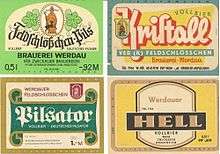Pilsner

Pilsner (also pilsener or simply pils) is a type of pale lager. It takes its name from the Bohemian city of Pilsen, where it was first produced in 1842.[1] The world’s first blond lager, the original Pilsner Urquell,[2] is still produced there today.
History

Origin
The city of Pilsen began brewing in 1295, but until the mid-1840s, most Bohemian beers were top-fermented. The taste and standards of quality often varied widely, and in 1838, consumers dumped whole barrels to show their dissatisfaction.[3] The officials of Pilsen founded a city-owned brewery in 1839, called Měšťanský pivovar Plzeň (German: Bürger-Brauerei, English: Citizens' Brewery – now Pilsner Urquell), which was to brew beer in the pioneering Bavarian style.[4] Brewers had begun aging beer made with cool fermenting yeasts in caves (lager, i.e., German: gelagert [stored]), which improved the beer's clarity and shelf-life. Part of this research benefited from the knowledge already expounded on in a book (printed in German in 1794, in Czech in 1799), written by Czech brewer František Ondřej Poupě (Ger: Franz Andreas Paupie) (1753–1805) from Brno.[5]
The Pilsen brewery recruited the Bavarian brewer Josef Groll (1813–1887) who, using new techniques and paler malts, presented his first batch of pale lager on 5 October 1842. The combination of brighter malt prepared by English technology, Pilsen's remarkably soft water, local Saaz noble hops from nearby Žatec and Bavarian-style lagering produced a clear, golden beer that was regarded as a sensation. Groll returned to Vilshofen three years later in 1845, and there later inherited his father's brewery.
Emergence of efficient glass manufacturing in Europe, around the same time, lowered glass prices. This allowed the general population to purchase glass drinking vessels for the first time. These former luxury items showcased the visually pleasing golden clarity of the recently invented Bohemian glass, further influencing the pilsner's rapid dissemination.
In 1853, the beer was available in 35 pubs in Prague, in 1856 came to Vienna and in 1862 to Paris. Improving transport and communications also meant that this new beer was soon available throughout Europe, and the Pilsner style of brewing was soon widely imitated. In 1859, “Pilsner Bier” was registered as a brand name at the Chamber of Commerce and Trade in Pilsen. In 1898, the Pilsner Urquell trade mark was created to put emphasis on being the original brewery (Urquell meaning original well, the English equivalent would probably be prototype pilsener beer).
Some beers are labeled Urtyp Pilsener (UP) meaning that they are brewed according to the original process, although many breweries use this accolade for their top beer.[6][7]
Modern developments
The introduction to Germany of modern refrigeration by Carl von Linde in the late 19th century eliminated the need for caves for beer storage, enabling the brewing of cool fermenting beer in many new locations.[8] Until recently the Pilsner Urquell brewery fermented its beer using open barrels in the cellars beneath their brewery. This changed in 1993 with the use of large cylindrical tanks. Small samples are still brewed in a traditional way for taste comparisons.
A modern pale lager termed a pilsner may have a very light, clear colour from pale to golden yellow, with varying levels of hop aroma and flavour. The alcohol strength of beers termed pilsner vary but are typically around 4.5%–5% (by volume). There are categories such as "European-Style Pilsner" at beer competitions such as the World Beer Cup. Pilsen style lagers are marketed internationally by numerous small brewers and larger conglomerates.
Styles
- German-style Pilsner
- light straw to golden colour with more bitter or earthy taste – Jever, Beck's, Bitburger, Flensburger, Holsten, König, Krombacher, Radeberger, Veltins, Warsteiner, Wernesgrüner, St Pauli Girl , Fürstenberg
- Czech-style Pilsner
- golden, full of colours, with high foaminess and lighter flavour – Pilsner Urquell, Budweiser, Gambrinus, Kozel, Svijany, Staropramen, Radegast
- European-style Pilsner
- has a slightly sweet taste, can be produced from other than barley malt – Dutch: Amstel, Grolsch, Heineken[9] or Belgian: Jupiler, Stella Artois[10]
See also
References
- ↑ Jackson, Michael. "Prague: twinned with Burton-upon-Trent". The Beer Hunter. Retrieved 28 April 2011.
- ↑ German Beer Institute, PILS Archived 19 October 2011 at the Wayback Machine.
- ↑ Oliver, Garrett (2011). Oxford Companion to Beer. Oxford University Press. p. 960. ISBN 978-0195367133.
- ↑ "Plzeňský Prazdroj, a. s." www.prazdroj.cz. Retrieved 17 October 2009.
- ↑ Basařová G.: Der legendäre böhmische Brauer František Ondřej Poupě (Franz Andreas Paupie) 1753–1805. Jahrbuch 2003 Gesellschaft für die Geschichte und Bibliographie des Brauwesens E.V. (GGB), (2003) 1, 128–146.
- ↑ Zipfer Urtyp on the RateBeer website
- ↑ [https://beerandbrewing.com/dictionary/jJqEnkSesv/austria/ Urtyp on the Craft Beer and Brewing website
- ↑ "Altbier im Alltag" by Genno Fonk, 1999, page 11
- ↑ "Heineken bier - Pils gebrouwen door Heineken Brouwerij". www.biernet.nl.
- ↑ "Michael Jackson's Beer Hunter - Belgium's Great Beers". www.beerhunter.com.
External links
| Wikimedia Commons has media related to Pilsner. |